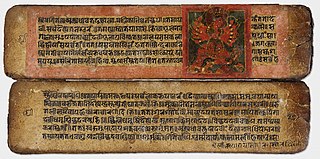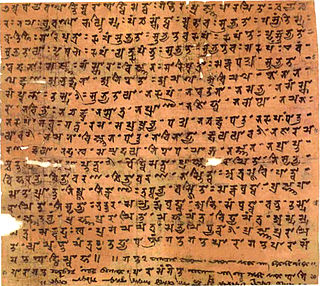Related Research Articles

Patanjali, also called Gonardiya or Gonikaputra, was a Hindu author, mystic and philosopher. Very little is known about him, and while no one knows exactly when he lived; from analysis of his works it is estimated that it was between the 2nd and 4th centuries CE.

Yoga is a group of physical, mental, and spiritual practices or disciplines which originated in ancient India and aim to control (yoke) and still the mind, recognizing a detached witness-consciousness untouched by the mind (Chitta) and mundane suffering (Duḥkha). There is a wide variety of schools of yoga, practices, and goals in Hinduism, Buddhism, and Jainism, and traditional and modern yoga is practiced worldwide.
Vedanta, also known as Uttara Mīmāṃsā, is a Hindu philosophical tradition that is considered one of the six orthodox (āstika) schools of Hindu philosophy. The word "Vedanta" means "end of the Vedas", and encompasses the ideas and philosophies present in the Upanishads, with a focus on knowledge and liberation. Vedanta developed into many sub-traditions, all of which base their ideas on the authority of a common group of texts called the Prasthānatrayī, translated as "the three sources": the Upanishads, the Brahma Sutras and the Bhagavad Gita.

Mahavira also known as Vardhaman, Mahavirswami, was the 24th tirthankara of Jainism. He was the spiritual successor of the 23rd tirthankara Parshvanatha. Mahavira was born in the early part of the 6th century BCE into a royal Kshatriya Jain family in ancient India. His mother's name was Trishala and his father's name was Siddhartha. They were lay devotees of Parshvanatha. Mahavira abandoned all worldly possessions at the age of about 30 and left home in pursuit of spiritual awakening, becoming an ascetic. Mahavira practiced intense meditation and severe austerities for twelve and a half years, after which he attained Kevala Jnana (omniscience). He preached for 30 years and attained Moksha (liberation) in the 6th century BCE, although the year varies by sect.
Shastra is a Sanskrit word that means "precept, rules, manual, compendium, book or treatise" in a general sense. The word is generally used as a suffix in the Indian literature context, for technical or specialigzed knowledge in a defined area of practice.

Mahabali, also known as Bali, Indrasenan, or Māveli, is a daitya king featured in Hinduism. He is the grandson of Prahlada, and a descendant of the sage Kashyapa. There are many versions of his legend, in ancient texts such as the Shatapatha Brahmana, Ramayana, Mahabharata, and several Puranas. According to Hindu literature, he was banished beneath the earth into the patala (netherworld) by the Vamana avatar of Vishnu.

Kaṇāda, also known as Ulūka, Kashyapa, Kaṇabhaksha, Kaṇabhuj was an ancient Indian natural scientist and philosopher who founded the Vaisheshika school of Indian philosophy that also represents the earliest Indian physics.

Sanskrit literature broadly comprises all literature in the Sanskrit language. This includes texts composed in the earliest attested descendant of the Proto-Indo-Aryan language known as Vedic Sanskrit, texts in Classical Sanskrit as well as some mixed and non-standard forms of Sanskrit. Literature in the older language begins with the composition of the Ṛg·veda between about 1500 and 1000 BCE, followed by other Vedic works right up to the time of the grammarian Pāṇini around 6th or 4th century BCE.

The Yoga Sutras of Patañjali is a collection of Sanskrit sutras (aphorisms) on the theory and practice of yoga – 195 sutras and 196 sutras. The Yoga Sutras was compiled in the early centuries CE, by the sage Patanjali in India who synthesized and organized knowledge about yoga from much older traditions.
In Sanskrit texts, Rāja yoga was both the goal of yoga and a method to attain it. The term also became a modern name for the practice of yoga in the 19th-century when Swami Vivekananda gave his interpretation of the Yoga Sutras of Patanjali in his book Raja Yoga. Since then, Rāja yoga has variously been called aṣṭāṅga yoga, royal yoga, royal union, sahaja marg, and classical yoga.
In Indian literature, Kāmashastra refers to the tradition of works on Kāma: Desire. It therefore has a practical orientation, similar to that of Arthashastra, the tradition of texts on politics and government. Just as the latter instructs kings and ministers about government, Kāmashastra aims to instruct the townsman (nāgarika) in the way to attain enjoyment and fulfillment.
Tolkāppiyam, also romanised as Tholkaappiyam, is the most ancient extant Tamil grammar text and the oldest extant long work of Tamil literature. The surviving manuscripts of the Tolkappiyam consists of three books (atikaram), each with nine chapters (iyal), with a cumulative total of 1,610 (483+463+664) sutras in the nūṛpā meter. It is a comprehensive text on grammar, and includes sutras on orthography, phonology, etymology, morphology, semantics, prosody, sentence structure and the significance of context in language.

The Nyāya Sūtras is an ancient Indian Sanskrit text composed by Akṣapāda Gautama, and the foundational text of the Nyaya school of Hindu philosophy. The date when the text was composed, and the biography of its author is unknown, but variously estimated between 6th-century BCE and 2nd-century CE. The text may have been composed by more than one author, over a period of time. The text consists of five books, with two chapters in each book, with a cumulative total of 528 aphoristic sutras, about rules of reason, logic, epistemology and metaphysics.
Vyākaraṇa refers to one of the six ancient Vedangas, ancillary science connected with the Vedas, which are scriptures in Hinduism. Vyākaraṇa is the study of grammar and linguistic analysis in Sanskrit language.
Mahabhashya, attributed to Patañjali, is a commentary on selected rules of Sanskrit grammar from Pāṇini's treatise, the Aṣṭādhyāyī, as well as Kātyāyana's Vārttika-sūtra, an elaboration of Pāṇini's grammar. It is dated to the 2nd century BCE.
Vaiśeṣika Sūtra, also called Kanada sutra, is an ancient Sanskrit text at the foundation of the Vaisheshika school of Hindu philosophy. The sutra was authored by the Hindu sage Kanada, also known as Kashyapa. According to some scholars, he flourished before the advent of Buddhism because the Vaiśeṣika Sūtra makes no mention of Buddhism or Buddhist doctrines; however, the details of Kanada's life are uncertain, and the Vaiśeṣika Sūtra was likely compiled sometime between 6th and 2nd century BCE, and finalized in the currently existing version before the start of the common era.
The Dashavatara are the ten primary avatars of Vishnu, a principal Hindu god. Vishnu is said to descend in the form of an avatar to restore cosmic order. The word Dashavatara derives from daśa, meaning "ten", and avatāra, roughly equivalent to "incarnation".
Assamese poetry is poetry in Assamese language. It borrows many themes from Sanskrit literature and is mainly devotional in tone. The origins of Assamese poetry are considered to have taken place in the early 13th century, the Bhagavat Purana is one of the most notable examples

Sanskrit Buddhist literature refers to Buddhist texts composed either in classical Sanskrit, in a register that has been called "Buddhist Hybrid Sanskrit", or a mixture of these two. Several non-Mahāyāna Nikāyas appear to have kept their canons in Sanskrit, the most prominent being the Sarvāstivāda school. Many Mahāyāna Sūtras and śāstras also survive in Buddhistic Sanskrit or in standard Sanskrit.

Shri Haridas Shastri (1918-2013) was an Indian Gaudiya Vaisnava scholar and practitioner. A prolific Sanskrit scholar, he wrote more than a sixty books, including translations from the Sanskrit of several Gauḍīyā books and his own commentaries on them. His original works include the highly regarded book, the Vedānta-darśanam bhāgavata bhāṣyopetam, his translation-cum-commentaries of the Sat Sandarbhas, and his transliterations of Śrī-caitanya-bhāgavata, Śrī-caitanya-caritāmṛta and Śrī-caitanya-maṅgala. Jonathan Edelmann at the University of Florida has called Shastri "arguably the most prolific and well-educated Gauḍīya Vaiṣṇava “insider” scholar of the twentieth century" and "a voice distinct from the more well known Gaudīya-Maṭha and ISKCON". Among his disciples is the noted Gauḍīyā scholar and practitioner, Dr. Satyanarayana Dasa.
References
- ↑ Encyclopaedic Dictionary of Pali Literature
- ↑ "The Philosophy of Riti - Yabaluri.org". Archived from the original on 30 December 2013. Retrieved 30 December 2013.
- ↑ Vamana definition of Vamana in the Free Online Encyclopedia.